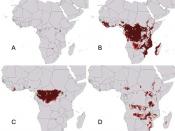INTRODUCTION
The most deadly killers on this earth are too small to see with the naked eye. These microscopic predators are viruses. In my report, I will answer many basic questions concerning one of the fastest killing viruses, the Ebola virus. Questions such as 'How does it infect its victims?', 'How are Ebola victims treated?', 'How are Ebola outbreaks controlled?' and many others
related to this deadly virus.
GENERAL INFORMATION
The Ebola virus is a member of the negative stranded RNA viruses known as filoviruses. There are four different strains of the Ebola virus - Zaire (EBOZ), Sudan (EBOS), Tai (EBOT) and Reston (EBOR). They are very similar except for small serological differences and gene sequence differences. The Reston Strain is the only one which does not affect humans. The Ebola virus was named after the Ebola river in Zaire, Africa after its first outbreak in 1976.
STRUCTURE
When magnified by an electron microscope, the ebola virus resembles long filaments and are threadlike in shape.
It usually is found in the form of a 'U-shape'. There are many 7nm spikes which are 10nm apart from each other visible on the surface of the virus. The average length and diameter of the virus is 920nm and 80nm. The virons are highly variable in length (polymorphic), some attaining lengths as long as 14000nm. The Ebola virus consists of a helical nucleocapsid, which is a protein coat and the nucleic acid it encloses, and a host cell membrane, which is a lipoprotein unit that surrounds the virus and derived form the host cell's membrane. The virus is composed of 7 polypeptides, a nucleoprotein, a glycoprotein, a polymerase and 4 other undesignated proteins. These proteins are synthesized by mRNA that are transcribed by the RNA of the virus. The genome consists of a...


